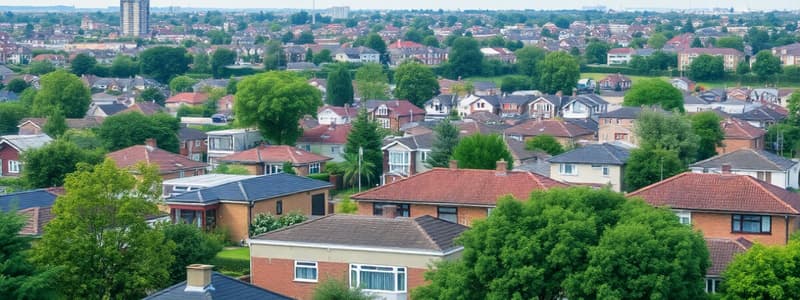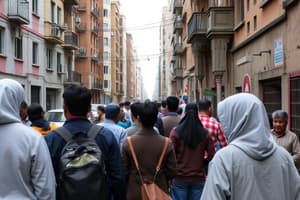Podcast
Questions and Answers
What does residential segregation primarily refer to?
What does residential segregation primarily refer to?
- The spatial separation of social groups within a geographic area. (correct)
- The physical separation of individuals based on their age.
- The economic disparity between different neighborhoods.
- The integration of diverse social groups in urban settings.
What factor can influence the tendency to move to a socially similar neighborhood?
What factor can influence the tendency to move to a socially similar neighborhood?
- The distance to the nearest park.
- The level of educational attainment.
- The socioeconomic status of an individual's family.
- The social distance between an individual and their neighborhood. (correct)
Which of the following is NOT mentioned as a characteristic basis for residential segregation?
Which of the following is NOT mentioned as a characteristic basis for residential segregation?
- Family structure
- Physical appearance (correct)
- Socioeconomic status
- Religion
What are new social risks associated with social exclusion?
What are new social risks associated with social exclusion?
What aspect of society is being compromised due to social exclusion?
What aspect of society is being compromised due to social exclusion?
What is the definition of character stigmas?
What is the definition of character stigmas?
Which strategy involves hiding a stigmatized attribute?
Which strategy involves hiding a stigmatized attribute?
How can negative associations about a territory arise?
How can negative associations about a territory arise?
What is a potential effect of residential segregation?
What is a potential effect of residential segregation?
What does self-perception in stigmatized areas often lead to?
What does self-perception in stigmatized areas often lead to?
What are protective effects of residential segregation particularly beneficial for?
What are protective effects of residential segregation particularly beneficial for?
What impact can stigmatization have on individuals living in a territory perceived as dangerous?
What impact can stigmatization have on individuals living in a territory perceived as dangerous?
What is a frequent outcome of territorial stigmatization?
What is a frequent outcome of territorial stigmatization?
What does the dissimilarity index measure in urban settings?
What does the dissimilarity index measure in urban settings?
How is a ghetto defined in the context of urban sociology?
How is a ghetto defined in the context of urban sociology?
What is the primary purpose of an enclave?
What is the primary purpose of an enclave?
What distinguishes a hyperghetto from a traditional ghetto?
What distinguishes a hyperghetto from a traditional ghetto?
What is territorial stigmatization?
What is territorial stigmatization?
According to the sociological perspective, what is stigma?
According to the sociological perspective, what is stigma?
What characterizes a citadel in spatial terms?
What characterizes a citadel in spatial terms?
What range on the dissimilarity index indicates low levels of segregation?
What range on the dissimilarity index indicates low levels of segregation?
Flashcards
Residential Segregation
Residential Segregation
The separation of different social groups within a specific area, like a city or county.
Social Distance and Neighborhood Segregation
Social Distance and Neighborhood Segregation
The tendency for people to live in neighborhoods with others similar to them in terms of social status. This can lead to limited social interaction between different groups.
New Social Risks
New Social Risks
Changes in the workforce, weakening social connections, and reduced government support can lead to people being left behind.
Working Poor
Working Poor
Signup and view all the flashcards
Social Exclusion
Social Exclusion
Signup and view all the flashcards
Dissimilarity Index
Dissimilarity Index
Signup and view all the flashcards
Ghetto
Ghetto
Signup and view all the flashcards
Enclave
Enclave
Signup and view all the flashcards
Citadel
Citadel
Signup and view all the flashcards
Outcast Ghetto
Outcast Ghetto
Signup and view all the flashcards
Hyperghetto
Hyperghetto
Signup and view all the flashcards
Hyperghetto Formation
Hyperghetto Formation
Signup and view all the flashcards
Territorial Stigmatization
Territorial Stigmatization
Signup and view all the flashcards
Character Stigma
Character Stigma
Signup and view all the flashcards
Group Stigma
Group Stigma
Signup and view all the flashcards
Dissimulation
Dissimulation
Signup and view all the flashcards
Correction
Correction
Signup and view all the flashcards
Acceptance
Acceptance
Signup and view all the flashcards
Territorial Stigma
Territorial Stigma
Signup and view all the flashcards
Effects of Residential Segregation
Effects of Residential Segregation
Signup and view all the flashcards
Study Notes
Social Exclusion and Segregation
- Segregation is the spatial separation of two or more social groups within a geographic area (e.g., city, county).
- Studies often examine how racial, ethnic, or national origin groups live in different neighborhoods.
- Segregation can be based on various characteristics, including religion, family structure, or socioeconomic status.
- Segregation occurs at different geographic levels (residential block, state, country).
Definition of Segregation
- Residential segregation generally refers to the spatial separation of two or more social groups within a defined geographic area.
- Scholarship commonly explores the extent to which groups (defined by race, ethnicity, nationality) live in distinct neighborhoods.
- Groups may also be residentially segregated based on other characteristics, like religion, family structure, or socioeconomic status.
Mumbai, India
- Image/example of a city with varying residential concentrations.
Spatial and Social Distance
- A 50+ year-old Chicago study found that spatial distance increases with social distance.
- High and low social categories tend to be highly segregated.
- Social mixing may happen, but only amongst groups with similar social statuses.
New Social Risks
- Factors contributing to social exclusion include labor market transformations, shrinking social ties, and welfare regime retrenchment.
- The working poor are on the rise and growing in number.
- Social exclusion involves the marginalization and separation of individuals from society, leading to breaks in social ties.
- Society's capacity for integration diminishes, leading to isolation, fragmentation, and poverty niches.
Measuring Segregation: Dissimilarity Index
- The dissimilarity index measures the evenness of people's distribution across neighborhoods in a city or metropolitan area.
- The index ranges from 0 to 100.
- Below 30: Low levels of segregation.
- 30-60: Moderate segregation.
- Over 60: High segregation.
Segregation in 2011 (England)
- Data visualizes segregation levels in Greater London, London (+100kms), and England.
- Data displays segregation levels for different ethnic groups (White British, Bangladeshi, Black African...).
- Visual representation shows index of dissimilarity relative to all other ethnic groups.
Ghetto, Enclave, and Citadel (Marcuse)
- Ghetto: A spatially concentrated area designed to separate and limit an involuntary population group perceived as inferior by the dominant society.
- Outcast ghetto: A ghetto with class and ethnicity factors, excluding residents from mainstream economic life.
- Enclave: A concentrated area where members of a specific group congregate to enhance economic, social, political, or cultural development.
- Citadel: A concentrated area where a superior group congregates to protect or enhance its position.
Stigma and Stigmatization
- Stigma is a social discredit based on characteristics deemed deviant from dominant norms (Goffman).
- Stigma can affect individuals and/or groups.
- Types of stigma include physical, character, and group stigma.
- Strategies for managing stigma include dissimulation, correction, and acceptance.
Negative Associations/Effects of Segregation
- Negative associations with an area can stem from socioeconomic conditions, crime, or urban decay.
- Media, policies, and discourse can create and reinforce negative perceptions.
- Such stigma impacts inhabitants, potentially leading to discrimination in job markets, housing, and service access.
- Self-perception can align with negative associations, creating social exclusion.
- Territorial stigmatization creates a vicious cycle.
Residential Segregation's Effects and Protective Factors
- The concentration of ethnic, national origin, or socioeconomic groups in particular neighborhoods.
- Effects include limited residential choices, restricted opportunities, concentrated poverty, and social exclusion.
- Segregation doesn't necessarily indicate a significant social crisis.
- Positive aspects include a familiar environment, social networks, information exchange, support, and self-employment funding—particularly beneficial for new comers.
Studying That Suits You
Use AI to generate personalized quizzes and flashcards to suit your learning preferences.




